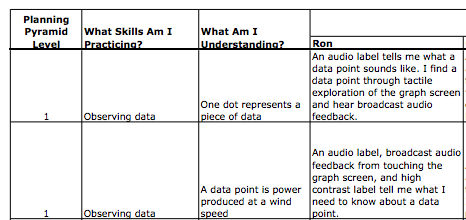CMME: Using Personas in Exhibit Development
Personas, or hypothetical archetypes of actual users, were created as part of the Creating Museum Media for Everyone (CMME) project. Each persona represents a potential visitor and their characteristics were developed using real user data. These personas were meant to help guide exhibit development teams to think about the exhibit experience for a wide range of users. You can read more about the development of the personas by clicking here. You can also view and download the most recent version of the personas by clicking here.
For the final CMME exhibit at the Museum of Science, we used the personas to help define the potential visitor experiences and identify where gaps in each user’s potential experience may exist.
This is a snapshot from the full persona goal planning document we developed. You can download the full version of our goal planning spreadsheet by clicking here.
When planning to use the personas, we first defined the skills a visitor would be practicing and what they would understand from each of those interactions, within three learning levels. These levels were based on the Planning Pyramid Degrees of Learning, as defined by Schumm, Vaughn, and Leavell (1994). The reinterpreted levels we used for the exhibit are:
- Level 1. What all visitors should learn
- Level 2. What most but not all visitors will learn
- Level 3. What some visitors will learn
Visitors need to understand and practice the skills at level one, in order to build on their learning in level two and level three interactions. An example of a level one goal is that visitors would use the skill of observing data to understand that one dot on the scatterplot graph represents a piece of data. This basic understanding is necessary for a visitor to understand all other elements in this graph-based exhibit.
We then extrapolated each of these skill/understanding pairs and defined how each of the persona examples would interact with the exhibit at that level. For example, when using the Cynthia persona we would first refer to her persona description for characteristics we needed to consider when imagining her interaction with the exhibit:
- Cynthia became blind as an adult, she desires specific (but not simplified) instructions, and relies on audio information to give her directions.
We would then write out, based on the exhibit design, how Cynthia might accomplish each goal.
- Level 2 goal: Visitors will practice describing data and understand there is a pattern in the data.
- Cynthia’s interaction: I detect a pattern in the data auditorily (broadcast audio). Audio (broadcast audio, sonification of the trend line, and audio text label) prompts help me observe patterns I might not have noticed.
We extrapolated the 13 interaction goals for each of the eight personas. This practice also revealed where there were holes in supporting visitor interactions, for example:
- Level 2 goal: Visitors will interact with the data by exploring details within the data.
- Some of Alec’s characteristics: Alec has Autism Spectrum Disorder, he is comfortable with computers, prefers quiet environments, and, when using interactives, he likes to be able to manage the amount of sensory stimulation he receives.
- Alec’s interaction for the level 2 goal: The current version has audio feedback always linked to tactile exploration. He would not have control over managing the amount of sensory stimulation he received while he was actively interacting with the graph. This would be a limiting factor for Alec’s interest and willingness to explore the details within the data.
Our team decided that not all goals needed to be met by all visitor personas. For example, we acknowledged that Molly, who has an intellectual disability and doesn’t particularly like science, might not interact with the exhibit for the level 3 goal of using data to compare/draw hypotheses and understanding that you can answer your questions by observing patterns in the data.
Going through the process of defining the degrees of learning goals for the exhibit enabled us to understand the ways in which we hoped a visitor might understand the exhibit. Writing out the specific experiences we imagined for each of the persona characters then enabled us to have a concrete vision of which components supported these visitor interactions, which components detracted from a visitor’s experience, and where there may be holes in the visitor experience.
How might you use the personas in exhibit development? Share your thoughts in the comments below.
Schumm, J.S., Vaughn, S., & Leavell, A.G. (May 1994). Planning pyramid: A framework for planning for diverse student needs during content area instruction. The reading teacher, 47 (8), 608-615.
by Emily O'Hara ![]() on December 30, 2014
on December 30, 2014
